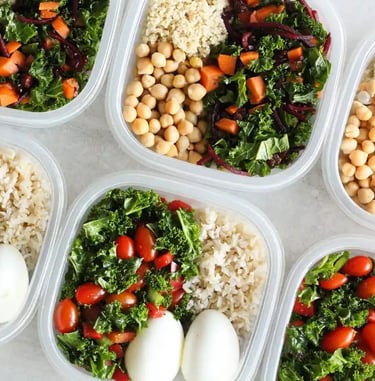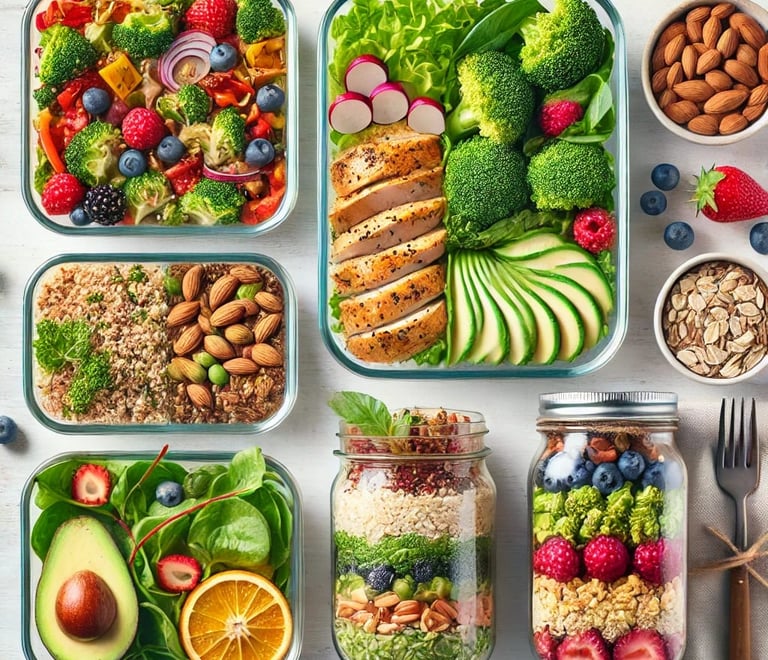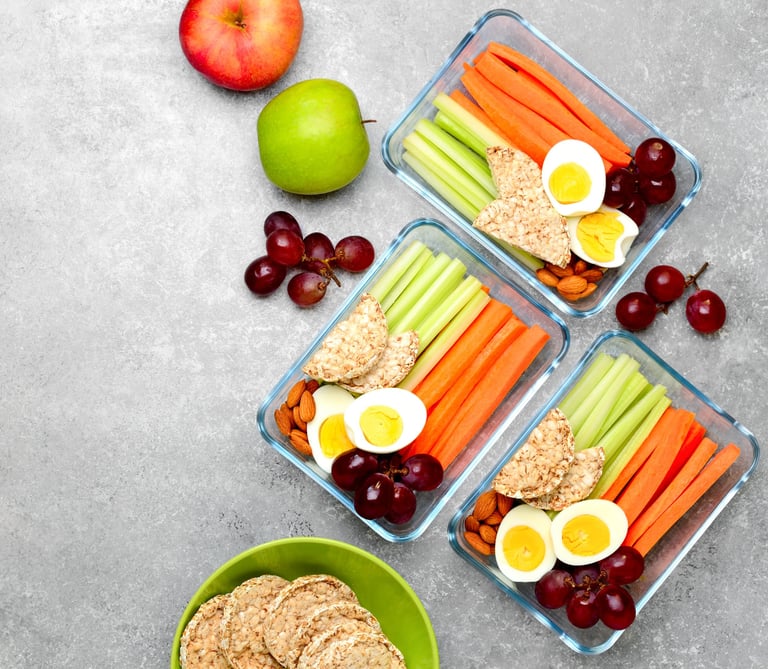Your 5-Step Success Guide to Meal Prep for Fat Loss
Learn how to meal prep for fat loss with this step-by-step guide. Discover time-saving tips, food choices, and storage hacks to stay on track with your weight loss goals.
NUTRITIONWEIGHT LOSS
by katesen
3/10/20253 min read
Introduction
Meal prepping is the secret weapon of anyone serious about losing fat and keeping it off. Between busy schedules, tempting takeout, and endless snack cravings, sticking to a fat-loss plan can feel impossible. But dedicating just 2–3 hours a week to meal prep can save time, money, and calories while ensuring you eat nutrient-dense meals that keep you full and energized. In this guide, we’ll break down exactly how to meal prep for fat loss—even if you’re a beginner.
1. Why Meal Prepping Works for Fat Loss
Meal prepping isn’t just for fitness influencers—it’s a science-backed strategy to stay consistent with your goals. Here’s why it works:
Portion Control: Pre-portioned meals prevent overeating.
Avoid Impulse Choices: No last-minute fast food runs when you’re hungry.
Save Time: Spend less time cooking daily.
Balance Macros: Easily hit protein, carb, and fat targets for fat loss.
A 2022 study in Obesity found that people who planned meals in advance lost 30% more weight than those who didn’t. By controlling ingredients and portions, you create a calorie deficit without feeling deprived.
2. Plan Your Fat-Loss Meals Like a Pro
Before you chop a single vegetable, planning is key. Follow these steps:
Calculate Your Calorie Needs
Use an online calculator to estimate your daily calories for fat loss (typically 300–500 calories below maintenance). Apps like MyFitnessPal simplify tracking.
Prioritize Protein
Protein keeps you full, preserves muscle, and boosts metabolism. Aim for 30–40% of daily calories from sources like:
Chicken breast
Greek yogurt
Lentils
Tofu
Build Balanced Meals
Divide your plate:
50% Veggies (spinach, broccoli, peppers)
25% Protein
25% Complex Carbs (quinoa, sweet potatoes, oats)
Add Healthy Fats (avocado, nuts, olive oil)
Sample Day:
Breakfast: Veggie omelet + oats
Lunch: Grilled chicken salad
Snack: Apple + almond butter
Dinner: Salmon + quinoa + roasted veggies
3. Choose Fat-Loss Friendly Foods
Not all calories are equal. Stock your kitchen with these staples:
Protein-Packed Foods
Eggs, turkey, shrimp, cottage cheese
Fiber-Rich Carbs
Berries, brown rice, chickpeas, zucchini
Healthy Fats
Chia seeds, walnuts, avocado oil
Avoid: Sugary snacks, refined carbs (white bread), and processed meats.
4. Step-by-Step Meal Prep Routine
Follow this efficient system to prep a week’s meals in 2 hours:
Step 1: Batch Cook Basics
Proteins: Grill chicken, bake salmon, or slow-cook lentils.
Carbs: Cook quinoa, roast sweet potatoes, or boil brown rice.
Veggies: Chop raw veggies for snacks and roast others (broccoli, Brussels sprouts).
Step 2: Assemble Meals
Use divided containers to portion proteins, carbs, and veggies. For example:
Meal 1: Chicken + quinoa + asparagus
Meal 2: Tofu stir-fry + cauliflower rice
Pro Tip: Freeze 2–3 meals to keep them fresh all week.
Step 3: Prep Snacks
Portion nuts, hard-boiled eggs, or veggie sticks into grab-and-go containers.
5. Store and Reheat Meals Safely
Keep your meals fresh and tasty:
Storage Tips
Fridge: Store meals for up to 4 days in airtight glass containers.
Freezer: Freeze soups, chilis, or casseroles for up to 3 months.
Reheating
Microwave veggies with a splash of water to prevent drying.
Reheat proteins gently (low heat) to maintain texture.
FAQs: Meal Prepping for Fat Loss
Q: Is meal prepping expensive?
A: No! Buying in bulk and using seasonal veggies cuts costs.
Q: What if I get bored with meals?
A: Use spices (paprika, cumin) and sauces (hot sauce, Greek yogurt dressing) to add variety.
Q: Can I meal prep without cooking?
A: Yes! Opt for no-cook meals like salads, wraps, or overnight oats.
Conclusion
Meal prepping for fat loss doesn’t have to be complicated. By planning balanced meals, batch cooking, and storing food properly, you’ll set yourself up for success. Remember, consistency—not perfection—is the key to lasting results. Start small, experiment with recipes, and watch your progress soar.
Call to Action: Ready to begin? Download our free 7-day fat-loss meal plan and shopping list to kickstart your journey!
Internal Links: “10 High-Protein Meal Prep Recipes” or “How to Track Macros for Weight Loss”
By combining practical strategies with science-backed advice, this guide empowers readers to take control of their nutrition and achieve sustainable fat loss. 🥑🍗






Wellness
Empowering you with knowledge for healthier living.
Fitness
Nutrition
+254721616602
© 2025. All rights reserved.
Affiliate Blog Disclaimer for YourHealthyPath.in
Last Updated: [1/6/2025]
At YourHealthyPath.in, we believe in transparency and building trust with our readers. This disclaimer outlines our affiliate relationships and how they impact the content you see. Please read this carefully to understand our commitments to you.
Affiliate Links & Compensation
Some links on this blog may be “affiliate links.” This means if you click on the link and purchase a product/service, we may earn a small commission at no extra cost to you. These partnerships help fund our work, allowing us to continue providing free, valuable content.
We only promote products or services we genuinely believe in, have researched, or have personal experience with. Our reviews and recommendations are always honest and unbiased, even when compensated.
FTC Compliance
YourHealthyPath.in complies with the Federal Trade Commission (FTC) guidelines for affiliate marketing. We disclose all affiliate relationships to ensure you’re fully informed about how our content is funded.
No Professional Advice
The content on this blog (including articles, reviews, and recommendations) is for informational purposes only and does not constitute professional medical, financial, or legal advice. Always consult a qualified expert before making decisions related to your health, finances, or well-being.
Amazon Associates Program
YourHealthyPath.in participates in the Amazon Services LLC Associates Program, an affiliate advertising program that allows sites to earn fees by linking to Amazon.com. As an Amazon Associate, we earn from qualifying purchases.
5Your Responsibility
While we strive to provide accurate and up-to-date information, product details, prices, and availability may change. Always verify details on the official product/service website before purchasing.
Questions?
If you have any concerns about our affiliate partnerships or content, feel free to contact us at [yourhealthpathin@gmail.com].
© YourHealthyPath.in | This disclaimer is subject to updates without notice.
